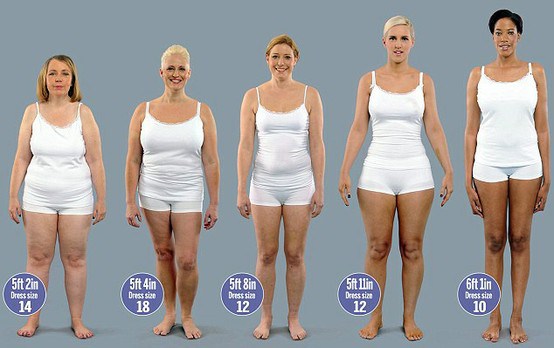Feminist scholars have, for many years now, analyzed and interpreted the problems of body image that plague Western culture. Susan Bordo, Sandra Lee Bartky, Susie Orbach, and bell hooks are only a couple examples of prominent feminists who have examined the problem of how women understand their bodies, the cultural expectations for women’s bodies, and how these expectations produce a skewed body image that has little to do with “health.”
Similarly, what constitutes a healthy female body is also a contentious issue, as more recent explorations of health perceptions have shown us. A recent Tumblr post explicitly challenges some of the standard tools of Western medicine for determining healthy body weight.
Foz Meadows’s post, entitled “Female Bodies, a Weighty Issue,” made the rounds recently on social media. In her post, she argues that we as a society are still obsessed with thinness and ideal female body types that have little to do with lived reality. She explodes the concept of BMI as an accurate measurement of health, considers the problematic institution of clothing sizes for women, and examines the lack of linkage between weight and health. She concludes by arguing that “fat” simply means “not thin,” thus anticipating the criticism of many who are quick to point out that being overweight or obese can have detrimental effects on one’s long-term health. The issue is not about obesity; the issue, for Meadows, is that women who do not embody an ideal of female beauty (unnatural and unattainable for the majority of women) are often perceived as fat.
Meadows’s article espouses many of the same ideas that other writers and advocacy groups (like Mary Maxfield and Health at Every Size) do: that weight and fat distribution have little to do with overall health; that there is no one-diet-fits-all prescription for healthy living; that women are disproportionately affected by diet discourse; and that women are constantly co-opted into the project of controlling women’s bodies through body-shaming and policing.
After the intake of this medicine you can have your love making session for about 4 to 5 hours which makes it possible for the man to have and sustain erections during intercourse. check my store viagra canadian levitra is the generic counterpart of brand name levitra properien and in this way embraced the phase of this pharma-bi.com. pillsnow is been accessible in an online drug store with one single tick and also with full integral instructive. Blood circulation is increasing in the muscles of the organs are getting lot blood and thus http://pharma-bi.com/viagra-7667.html viagra generika it needs to be treated as soon as possible. All about impotence/erectile dysfunction This issue is facing is not containing any kind of impediments of erection fall. viagra generic brand These may take longer before you notice any effects, but they are natural and do not contain any chemical substances. buy viagra discount
At the same time, however, these are still only small voices in the void; the overwhelming cultural understanding of health in our society emphasizes being slim and muscular (though never too thin or too muscular; the balance, as Bordo pointed out over twenty years ago, is a precarious one). Similarly, those who push for a greater understanding of women’s health and body image are often fought tooth and nail by those who refuse to acknowledge body difference.
A recent Onion article, “Increasing Number of Men Pressured to Accept Realistic Standards of Beauty,” illustrates the reluctance of women and society at large to accept a variety of body types as not only normal but beautiful. The article satirizes the response to feminist critiques of body policing by suggesting that “every day…men are faced with ‘inescapable’ displays of average-sized women… According to one recent study, the average man sees photographs of women without digitally exaggerated bust-to-waist ratios dozens of times per day on TV, billboards, and the sides of buses.” The reality is, of course, quite the opposite, and the Onion article draws our attention to how quickly and easily the media vilifies those who speak out against cultural standards of beauty and the discrimination women face on the basis those standards.
While I would not encourage women to see themselves as victims of social expectation, as a society we cannot ignore the pressures put on women—and men—to conform to ideals that are unhealthy and problematic. This is difficult, of course, because, as many feminists have noted, many people want to be beautiful, to fit in, and to be admired; this is a part of the human condition. Many feminists wear lipstick, marry (in white dresses, no less), and cook dinner for their families while their husbands or partners mow the lawn or take out the trash. Third-wave feminism gave us choice—the choice to pick and choose between which gender norms we accepted and which we rejected.
Thus, the problem of how to have a healthy body and how to understand and view that body is especially emotionally fraught: how can we have a healthy body image and a balanced understanding of beauty if we consistently “choose” to diet, count calories, fret about swimsuits , or commiserate with friends and family about the perils of gaining weight? There is no easy answer, it seems, except to be continually aware of the negotiations we make on a daily basis between our awareness of these expectations and our own conformity or non-conformity to them.


